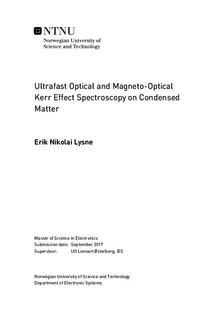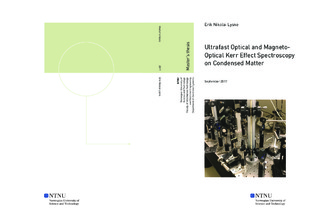| dc.description.abstract | In this masters project, an ultrafast optical spectroscopy system has been constructed and tested. The system was built as an extension to an existing spectroscopy system, centered around a mode-locked Ti:Sapphire femtosecond laser, optically amplified by a Q-switched, frequency-doubled Nd:YLF laser. The previous system was based on principles of nonlin- ear optics, and was used to measure third-order nonlinear effects. The goal of the project was to create a system that could perform measurements of magnetic and third-order non- linear properties in condensed matter. The work lead to improvements in detection and signal analysis, and inclusion of magneto-optical measurements based on the longitudinal magneto-optical Kerr effect. The functionality of the system was experimentally verified through measurements on permalloy (Ni0.8Fe0.2) grown on fused silica (SiO2), optically coated with zirconium dioxide (ZrO2). Optical demagnetization was also tested, and the demagnetization and recovery transients were resolved in time, using ultrafast optical mea- surement techniques. This proved to be feasible with the current system. Further work is however required to gain a detailed analysis of the time-resolved measurements.
The ultrafast nonlinear optical capabilities were also tested through measurements on deionized water (H2O) and acetone ((CH3)2CO). Several samples with films of iron-doped zinc sulfide (Fe:ZnS) on sapphire (Al2O3) substrate were characterized, on request from another group of researchers. The third-order nonlinear susceptibility was calculated based on these measurements, and was found to conform well with values obtained by others. The Raman spectrum of water was also calculated based on nonlinear measurements, to test the possibility of retrieving spectral information from the time-resolved measurements. The bandwidth of the laser was 14 THz, and it is believed that spectral features as high as 12 THz could be resolved in the analysis of the Raman spectrum. | |

